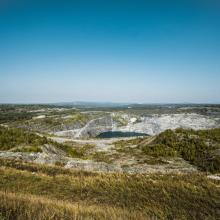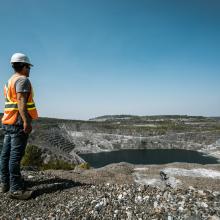Image set

Related services
Opening article section
Article section
Lead
Rich text
Olivier Sylvestre, Regional Director, Soil and Biomass Processing Centres for the Eastern Townships of Québec, talks about the Jeffrey Mine revegetation project, a former asbestos mine located in the town of Val des Sources (formerly known as Asbestos). The project, which began in 2004, is still underway today.
What was the revegetation project all about?
Upon closure of a mine, revegetation work begins.
A revegetation project consists of putting biomass, a renewable organic material that comes from plants and animals, back on a surface that cannot support vegetation on its own, even after a significant period of time has elapsed.
Olivier’s team effectively created soil from fertilizing organic waste (FOW) which enabled them to grow biomass (or organic matter). This biomass has the potential to be used in a variety of farming or energy projects. Here’s how they did it.
Article quote
Rich text
When one person’s waste becomes another person’s wealth
By mixing different sources of biomass in agronomically-suited proportions, a very fertile matrix of organic substance is produced that can be spread on mining surfaces. The site is then seeded and eventually reforested.
Our project uses FOW and low-level AB (residential grade) soils to create a growth matrix to cultivate vegetation on the Jeffrey Mine waste rock sites. In doing so, we are reclaiming organic residual materials and minimally contaminated soils.
- The fertilizing waste substances are mainly carbonaceous materials such as pulp and paper mill de-inking sludge and nitrogen-rich sewage sludge, more commonly known as biosolids.
- The residual calcium materials are essentially ashes from biomass incinerators and gypsum sludge, among others.
Since the Jeffrey Mine project began, we have recovered several hundred thousand tons of FOW and vegetated over 250 hectares of mine waste rock.
Englobe biodiversity specialists have studied the impacts of the Jeffrey Mine revegetation project. The results are impressive for both flora and fauna! They observed the return of insects, reptiles and birds. Delighted with these results, Olivier wondered what he could do to go even further…
Enter the bees!
In our Earth Day article, we announced Englobe’s partnership with Alvéole, a Quebec-based beekeeping and honey production company. Olivier had the idea of introducing bees to the mine site, so that they would contribute to the vegetation by pollinating. So, Englobe works with a honey factory that provides the bees and gives us honey from our revegetation project.
The initiative is causing quite a buzz among the local population – so much so that Olivier has proposed to local brewers to co-create a honey brown lager! Does this mark Englobe’s debut in the brewing industry? One thing’s for sure: life has returned to the Jeffrey Mine site!
Media
Rich text
What’s next?
The City of Val-des-Sources, which owns part of the land where the Jeffrey Mine is located, wishes to continue working with Englobe to revitalize the site. There are many projects in the works: development of a bicycle path, a central square and a public market – not to mention the slackline festival, which will hold its third edition in 2021. This new local attraction, for which Englobe is proud to have collaborated, will allow visitors to see tightrope walkers cross the two kilometre-span of the mine shaft. In addition, facilities are being built near the mine to transform what remains of the asbestos rock into magnesium. In short, there is no shortage of collaborative projects in sight for Olivier and his team!
Article quote
Headline
Statistic
Content
Carousel
Image set

Image set

Article section
Rich text
Englobe creates a local loop for sustainable development
Englobe’s team of fixed treatment centres manages four sites in the Eastern Townships, including the soil treatment site in Sherbrooke, the regional biomass recuperation centre in Bury, the sludge supply to the Kruger co-generation plant in Bromptonville and of course, the Jeffrey Mine revegetation project in Val des Sources.
The synergy created among the different centres that contribute in their own way to the Jeffrey Mine site’s revegetation, has generated an ingenious idea: a plan to integrate the four sites into a sustainable development loop.
- The sludge from the pulp and paper mill provides a prime material for producing a rich organic fertilizer, most of which is used by local farmers who prize it for its high mineral and carbon content.
- The remainder which is not used for agriculture for seasonal reasons, is sent to the former Jeffrey Mine site. Thanks to a contract with area municipalities, when combined with biosolids, this mixture forms a fertile substrate which is ideal for mine revegetation.
Unlike agricultural land that becomes muddy and loose in the spring and fall, the rocky soil of the mine can support the weight of huge truckloads of fertilizing waste material. This advantage, although unexpected, is excellent news that facilitates Englobe’s operations.
Article quote
Rich text
Today, we are the proud sponsors of the Mayor’s annual golf tournament, the Fête des gourmands food festival and a unique event that is gaining notoriety in Quebec: Slackfest. During this festival, a two-kilometre slackline (elastic strap) is suspended above the old Jeffrey Mine shaft, and the most daring are invited to cross it! Music, food, drinks and games enliven Slackfest, which holds the Guinness record for the longest slackline in the world.